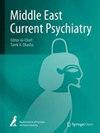Anxiety, mindfulness and self-efficacy association among university healthcare specialties students in Al Qassim, Saudi Arabia: a cross-sectional study
IF 1.6
Q3 PSYCHIATRY
引用次数: 0
Abstract
Anxiety is a widely recognized topic in medical education. Previous studies have found that medical students experience higher levels of anxiety than other students. An increasing corpus of research indicates a major association between mindfulness and mental wellness. This study included 418 respondents, of whom 394 were included in the final sample. Most were female (55.3%), while male participants comprised 44.7%. The mean age of the population was 22.4 years. Our results showed only 7.2% of the participants in the sample were diagnosed with mental health disorders. Moreover, 26% of the study population had minimal anxiety, and the proportions of those with mild, moderate, and severe anxiety ranged from 20.3% for mild, to 22.7% for moderate, to 31.1% for severe. The most commonly observed severe symptoms were fear of the worst happening, nervousness, and inability to relax. The mean score on the General Self-Efficacy Scale (GSE) was 27.7 (SD: 5.1) on a scale of 10–40. According to the short-form Five Facet Mindfulness Questionnaire (FFMQ-15) evaluation of participants’ mindfulness, the average score was 41.6 (SD: 9.5) on a scale of 15–75. Gender, college attended, and presence of psychiatric diagnosis were the independent factors potentially influencing Beck Anxiety Inventory (BAI) scores. Our findings revealed the prevalence of anxiety and mindfulness among healthcare students at Qassim University, Saudi Arabia. Weak correlations were found among the GSE, FFMQ-15, and BAI scores.沙特阿拉伯 Al Qassim 大学医疗保健专业学生的焦虑、正念和自我效能相关性:一项横断面研究
焦虑是医学教育中一个广为人知的话题。以往的研究发现,医学生的焦虑程度高于其他学生。越来越多的研究表明,正念与心理健康之间存在重要联系。本研究包括 418 名受访者,其中 394 人被纳入最终样本。大多数受访者为女性(55.3%),男性受访者占 44.7%。参与者的平均年龄为 22.4 岁。我们的结果显示,样本中只有 7.2% 的参与者被诊断患有精神疾病。此外,26%的研究对象有轻微焦虑,轻度、中度和重度焦虑的比例分别为 20.3%、22.7% 和 31.1%。最常见的严重症状是害怕最坏的事情发生、紧张和无法放松。一般自我效能感量表(GSE)的平均得分为 27.7(标准差:5.1),10-40 分。根据短式五面正念问卷(FFMQ-15)对参与者的正念进行评估,平均得分为 41.6(标准差:9.5),分值为 15-75 分。性别、就读院校和是否患有精神疾病是潜在影响贝克焦虑量表(BAI)得分的独立因素。我们的研究结果表明,沙特阿拉伯卡西姆大学的医学生普遍存在焦虑和正念问题。在 GSE、FFMQ-15 和 BAI 分数之间发现了微弱的相关性。
本文章由计算机程序翻译,如有差异,请以英文原文为准。
求助全文
约1分钟内获得全文
求助全文
来源期刊

Middle East Current Psychiatry
Medicine-Psychiatry and Mental Health
CiteScore
3.00
自引率
0.00%
发文量
89
审稿时长
9 weeks
 求助内容:
求助内容: 应助结果提醒方式:
应助结果提醒方式:


